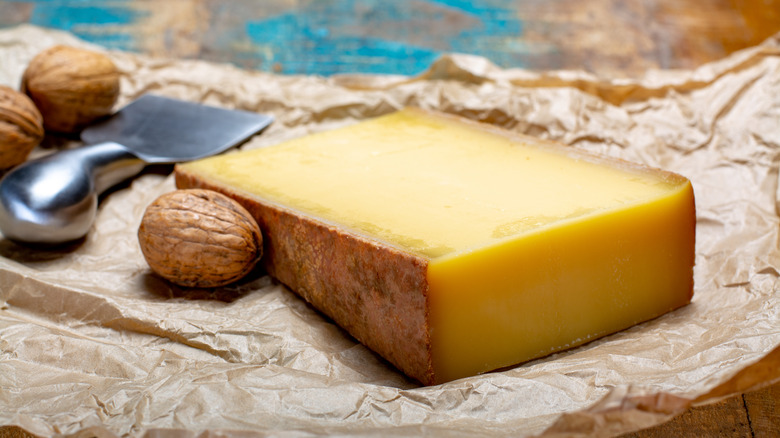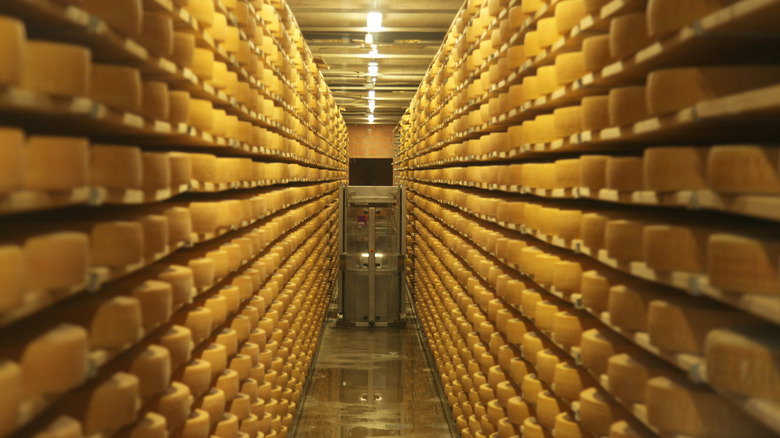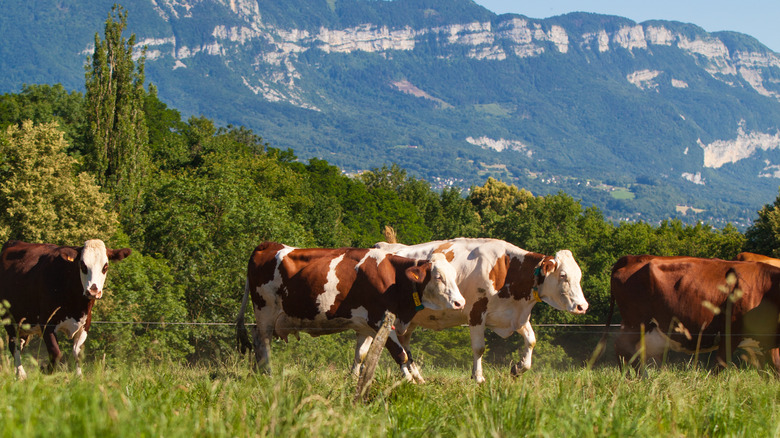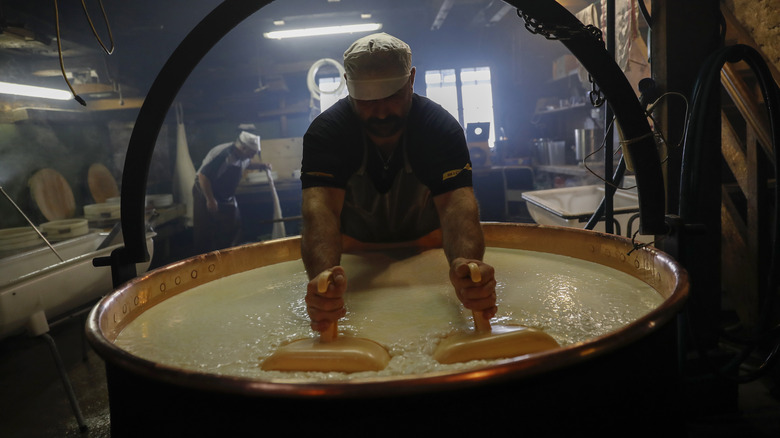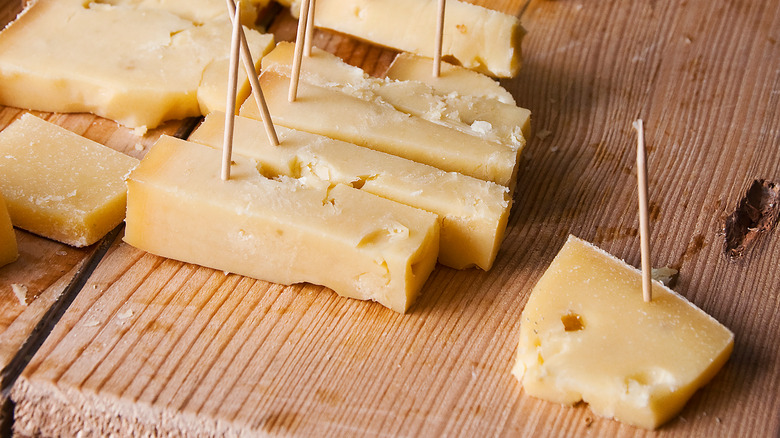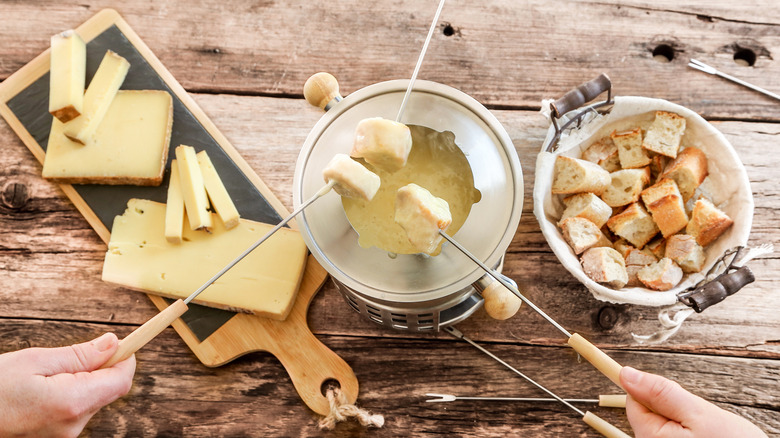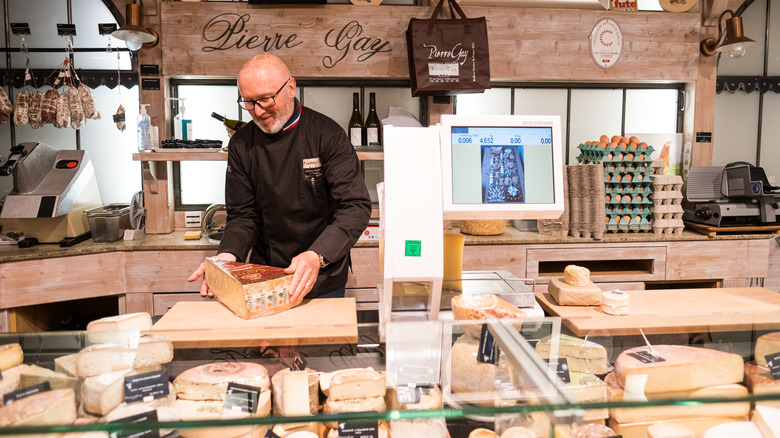What Is Gruyère Cheese And What Does It Taste Like?
You may know Swiss cheese as the one with the big holes, or the one that goes well with ham in omelettes and chicken cordon bleu, but in Switzerland, the most popular kind isn't what we refer to as "Swiss cheese," but rather, Gruyère (via Insider). Gruyère is a hard, aged cheese with only a few small holes, and not only is it the ingredient behind the most famous cheese recipe to come out of Switzerland — fondue — it's also the go-to cheese for everyday Swiss cooking.
Gruyère cheese gets its name from the small town of Gruyère, located in the French-speaking region of Fribourg, and it's so heavily consumed that an average of 30,000 tons of Gruyère are produced each year. The cheese makes its way to kitchens all across Switzerland and beyond, thanks to its incomparable versatility and distinct yet mild flavor. Yet despite Gruyère being the number one consumed cheese in Switzerland, the cheesemakers at the Maison du Gruyère, the flagship Gruyère manufacturer, never sacrifice quality for quantity. According to the official Gruyère website, only Gruyère produced in the region of Fribourg can be called Gruyère, so every wheel sold is guaranteed to be authentic and high quality.
What are the origins of Gruyère?
Le Gruyère Switzerland reported that the production of Gruyère can be traced all the way back to the 12th century, making it a cornerstone of Swiss culture and tradition. As early as the 17th century, the cheese was already being exported outside of Switzerland, and as demand increased, by 1762, Gruyère's origin was specified on every wheel in order to indicate authenticity. It wasn't until 2001, however, that Gruyère received its official Appellation d'Origine Protégée (AOP) status from the EU — which translates to Protected Designation of Origin, according to Cheeses From Switzerland.
The AOP status ensures that every wheel of Gruyère is made exactly the same way, in adherence to its longstanding medieval tradition. According to the standards set by the Maison du Gruyère, real Gruyère must be made using unpasteurized milk from natural-fed cows from dairy farms that are no more than 20 kilometers away, and during the five-month aging process, the cheese must be stored at 15 degrees C in high humidity on wooden shelves. Any deviation from this, and it cannot be sold as Gruyère.
What differentiates Gruyère from other Swiss cheeses?
As demonstrated by the Maison du Gruyère, it all starts in the green pastures of Fribourg. The variety and nutritional quality of grass in this region of Switzerland creates some of the best milk in the world and is what gives Gruyère its unmistakable flavor. Fribourg farmers, therefore, are required to follow strict guidelines when cultivating their pastures and allowing their livestock to graze.
Due to the different floral species in the five areas of Fribourg — Gruyère, Bern, Jura, Vaud, and Neuchâtel — the milk produced by the carefully monitored cows will slightly vary from pasture to pasture, making it impossible to replicate the flavor anywhere else. Each Gruyère-producing cow must consume at least 100 kilos of grass a day to produce the highest quality milk. This milk is delivered from the farmers to the Gruyère manufacturer twice a day to ensure freshness — once at dawn, and once late at night.
How is Gruyère made?
At the break of dawn, fresh unpasteurized milk straight from the dairy farms is added into large copper vats filled with milk from the night before. It's then partially skimmed and heated to exactly 32 degrees C before a cheesemaker adds starter cultures and rennet. This is when the curds begin to form. The curds are cut only when they've reached the perfect consistency — a consistency that can only be eyeballed by a well-trained Gruyère cheesemaker, Le Gruyère Switzerland explained.
During this stage, the cheese is gradually heated to 57 degrees C. Only when the texture and elasticity reach peak form is the cheese transferred into round molds that are pressed and rotated for a 16-hour period. At dawn the following day, the wheels are ready to be removed from their molds and transferred to a salty brine bath for 24 hours. Finally, the wheels are left to mature in a humid cellar where they are regularly rotated and brushed with salt water until a hard rind forms (via Le Gruyère Switzerland). After five months, the Gruyère flavor is fully developed and is ready for consumption — only after it passes the quality control test, however.
What does Gruyère taste like?
There are four types of Gruyère — Gruyère Classic, Gruyère Réserve, Gruyère Bio, and Gruyère d'Alpage (via Le Gruyère Switzerland). While they can all be used interchangeably in recipes that require Gruyère, each of them has its own unique flavor. Of course, all Gruyère is rich, creamy, and nutty, but depending on the climate during its production and the length of the aging period, the more or less pronounced the flavors are.
The most common form of Gruyère is simply called Gruyère Classic. This is the standard form of Gruyère, which is aged from six to nine months and has a soft texture and flavor. Gruyère Réserve, on the other hand, is any Gruyère that's older than 10 months. The flavor is more intense, and unlike regular Gruyère, it is significantly firmer and crumblier.
Gruyère Bio is Gruyère made with organic milk, under the specifications set by Bio Suisse, Switzerland's organization of organic agriculture. Gruyère Bio is similar in flavor to Gruyère Classic, but becomes more full-bodied as it continues to age. Gruyère d'Alpage is a smaller, cloth-pressed Gruyère produced specifically from mid-May to mid-October using the milk of mountain cows that graze on the alpine flora high in the Alps, which give it a refined, earthy flavor.
What foods taste best with Gruyère?
Most hard cheeses, like Parmigiano-Reggiano or Grana Padano, aren't considered a great option for melting or for use in sauces, but for Gruyère, it's quite the opposite. After all, it's the main cheese used in fondue, which is literally a pot of melted cheese. It's also the main cheese used in croque monsieur sandwiches, potatoes au gratin, and quiche lorraine (via Taste of Home). Gruyère is the make-or-break ingredient of so many classic recipes, and it's a great way to give otherwise plain cheese-based dishes, like macaroni and cheese, a gourmet touch.
Gruyère doesn't always have to be melted and tastes just as delicious when eaten in its natural form, on its own, with bread, or on a charcuterie board. Grapes & Grains recommends pairing it with brown ales or amber ales, as the nutty flavor of the Gruyère will complement the nutty undertones of the beer. If you prefer wine, the fruitier the better, as Gruyère tends to go well with fruity flavors whether it be in a wine glass or on a charcuterie board.
Where can you buy Gruyère?
While the best Gruyère is right in Switzerland, any Gruyère outside of Europe is just as authentic, as long as it's marked with the AOP seal. Most supermarkets will sell wedges of Gruyère Classic in their gourmet cheese section, according to The Spruce Eats, but to get special varieties like Gruyère Réserve, Gruyère Bio, and Gruyère d'Alpage, you may have to visit a cheesemonger instead.
Because all authentic Gruyère is imported, it is on the relatively expensive side compared to other cheeses. If you're planning to make a recipe that requires a lot, such as fondue, it fortunately melts well when combined with other Swiss cheeses. (The Spruce Eats specifically recommended Emmental, Jarlsberg, Beaufort, comté, or raclette.) There's a chance you'll find different brands of Gruyère from different parts of Fribourg, but because all Gruyère is produced under the same AOP standards, you can't go wrong with whatever you pick — just make sure you actually pick Gruyère, not the one deceptively called "Swiss cheese."
